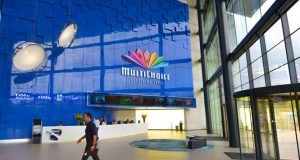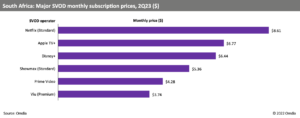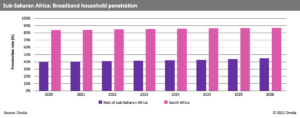
After more than 40 years of operation, DTVE is closing its doors and our website will no longer be updated daily. Thank you for all of your support.
Inside MultiChoice’s connected TV strategy
 The MultiChoice Group has been under pressure in Africa, facing stiff competition from the entry of new OTT streamers across the region and tougher economic conditions for its consumers in its home market of South Africa.
The MultiChoice Group has been under pressure in Africa, facing stiff competition from the entry of new OTT streamers across the region and tougher economic conditions for its consumers in its home market of South Africa.
The company is reacting by evolving from a traditional TV/video entertainment business and pivoting into a diversified platform business focused on technology and content aggregation. It launched DStv Streama in October 2022 and became a syndication partner for the Sky Glass connected TV device in September 2022.
The DStv Streama digital media player allows users to stream content from different suppliers while using one device. As a connected device, it allows users to stream from a variety of apps, including DStv, Showmax, SuperSport, Netflix, Amazon Prime Video, YouTube, and YouTube Kids. The DStv Streama does not have a dedicated app store but comes with pre-loaded apps ready for use. Streama is available as a standalone device, so it does not require an active DStv subscription – unless one wishes to stream DStv content. Unlike traditional pay TV decoders, no installation or satellite dish is required.
Disney+ is the latest third-party content provider to join DStv Streama, with Disney content landing on the streaming box in December 2022. This follows the launch of the Disney+ app in South Africa in May 2022.
MultiChoice and Disney have built a well-established long-term relationship, with Disney supplying content for MultiChoice’s TV services for several years, and the Disney streaming service has been made available to South African DStv subscribers via the MultiChoice Explora Ultra decoder. Showmax and Netflix are still the market leaders in the SVOD category in South Africa, with Omdia forecasting that both platforms will have over 1.2 million subscribers each by the end of 2023, so this partnership with DStv Streama is an avenue for the Walt Disney Company Africa to accelerate its subscriber growth in the country. MultiChoice previously announced partnerships with Netflix and Amazon Prime Video in 2020, making their offerings accessible through its decoder.
Unlike the price bundling strategies that some operators in mature markets and sub-Saharan Africa are pursuing, the MultiChoice streaming box is building an entertainment hub that unifies access to third- party streaming platforms via a platform integration deal only. Users will still have to subscribe to each platform individually to view the content, which could limit impact and adoption due to high pricing, even
if access is made easier via DStv Streama. It could also be argued that this strategy will make it easier for DStv users to subscribe to third-party platforms, such as Netflix, which are in direct competition with MultiChoice Group’s own streaming platform Showmax.
In September 2022, MultiChoice became Sky’s second global syndication partner for its Glass smart TV offering, following in the footsteps of Foxtel in Australia. Sky Glass styles itself as “a world-class content and app aggregation platform,” using Comcast’s global technology platform. It promotes the device as being able to find content easily using voice search and intelligent recommendations. The partnership aims to bolster MultiChoice’s streaming offering by giving access to TV channels and streaming platforms on the same device. The pay TV operator also plans in 2023 to launch its own-branded version of the connected TV, DStv Glass, which will be equipped with a 4K flat screen and sold in partnership with Sky.
However, the development of fully integrated TVs in sub-Saharan Africa is still embryonic, and ambitious growth targets are likely to be challenged by the relatively high cost of equipment for consumers and poor internet connectivity in most parts of the subregion.
All-in-one bundles
In response to the economic headwinds and internet connectivity challenges facing consumers in South Africa, MultiChoice introduced a new bundle package in November 2022, following the launch of DStv Internet in September 2021. This new bundle will provide customers with more choices and pass significant savings on to already constrained consumers.
The DStv Streama is not intended to replace a DStv decoder, so market share cannibalization is unlikely here. Rather, it is a standalone device that uses high- speed internet to deliver content, whereas the Explora decoders use satellite. This is an important distinction to make and will likely govern the rollout of Streama in the wider sub-Saharan African region, given that Omdia forecasts broadband household penetration rates in South Africa to reach almost 87% in 2027, compared to just over 45% in the rest of sub-Saharan Africa.
MultiChoice also faces significant competition from connected TV manufacturers such as Samsung and Hisense, which was the launch partner of the free OTT platform SABC+ in November 2022, using Hisense’s VIDAA smart TV operating system. Consequently,
the DStv app is no longer supported on Samsung and Hisense devices as MultiChoice Group pushes subscribers toward its DStv Streama and DStv Glass devices. This move has marked a line in the sand, reinforcing MultiChoice Group’s commitment to its connected TV strategy. The fibre internet bundling play could boost the wider streaming ecosystem in the region by lowering internet access costs, which has been cited as a major obstacle to wider SVOD subscriber penetration in sub-Saharan Africa.
Smart TV business model
Just a few years ago, TV sets – like most other consumer electronics products – were sold on a cost- plus-markup model. New revenue sources emerged as TVs gained internet connectivity: conventional linear TV (over-the-air broadcast, cable, and satellite) gave way to internet streaming. Smart TV platforms could gain a place in the advertising and viewing data market, delivering platform profits that exceeded TV hardware margins. With a strategy to grow users and engagement, then monetize, a strong incentive emerged to reduce hardware margins in favour of platform profits. Essentially there are two strategies that are not equally valuable to advertisers. The smart TV platform battle will be won or lost on a household’s main viewing set. Secondary TVs in the kitchen or spare room do not get enough engagement to justify the investment.
Also, in this new smart TV business model – which is driven by platform monetization – the model does not work equally well in all regions. The number of smart TVs shipped per region does not correlate with the region’s profitability. The concentration of ad spending and ease of access to a large common-language market with big national retailers makes North America uniquely attractive.
The important question, therefore, is whether the US profit model for connected TV can enable a TV strategy pivot in other regions around the world, such as South Africa. Operating systems need to sell advertising localized to the country level, owing to cultural and language differences within regions. This means there are only a few markets that can be profitably developed using the hardware at cost and profits by advertising approach. But Omdia notes that the environment is always evolving, and opportunities will continue to open up in different locations.
Samuel Nkwam is research analyst, TV & online video at Omdia. Patrick Horner is practice leader, consumer electronics and devices at Omdia.

